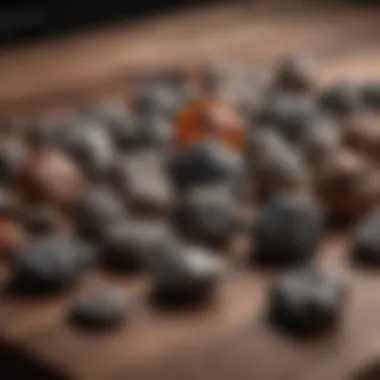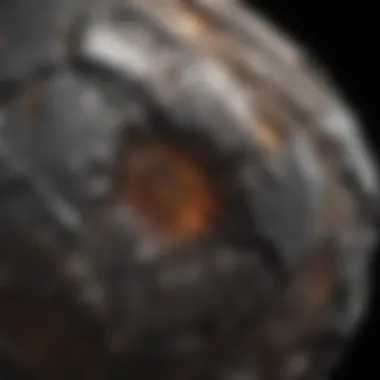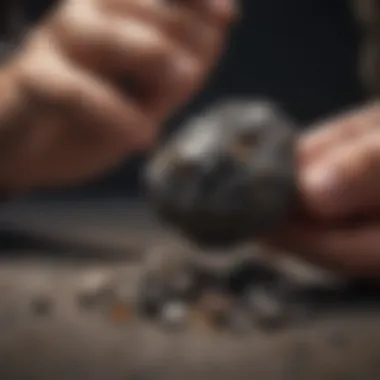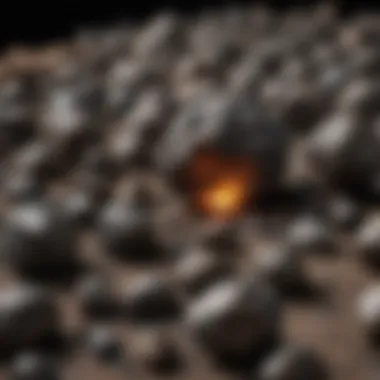Guide to Purchasing Meteorites: Key Considerations


Intro
Acquiring meteorites is a fascinating endeavor. These cosmic remnants hold a combination of scientific value and collector's appeal. The market for meteorites has grown, attracting enthusiasts and serious collectors alike. However, stepping into this realm requires a deep understanding of various elements.
Understanding how to identify meteorites accurately is pivotal. The rich history associated with each piece adds to its allure. Knowledgeable collectors know that sourcing is equally vital; reputable sellers can make a significant difference. Furthermore, pricing can vary widely based on various factors. Such complexity may be daunting for newcomers. But this guide aims to educate and inform, providing the insight necessary for making wise decisions.
Over the next sections, you will learn about identification techniques, sources, pricing strategies, and preservation methods. This journey will enable you to navigate the meteorite market effectively.
Featured Collectible of the Month
Overview
Each month, one collectible meteorite will be highlighted. This month, we focus on the Allende meteorite. Discovered in Mexico in 1969, it is known for its abundant chondrules and inclusions, making it a favorite among collectors. Understanding this meteorite’s features helps potential buyers gain insight into what makes a specimen valuable.
Historical Significance
The Allende meteorite holds substantial scientific importance. It is considered the largest carbonaceous chondrite ever found on Earth. Its study has provided insight into the solar system's early history. Therefore, acquiring such a piece not only adds to a collection but also contributes to ongoing research.
Identification Techniques
Identifying meteorites isn’t always straightforward. Numerous factors come into play, including visual characteristics and physical attributes. Understanding these traits helps distinguish them from terrestrial rocks.
Visual Characteristics
Some key visual characteristics include:
- Fusion crust: A thin, dark exterior formed during atmospheric entry.
- Chondrules: Small, round particles visible in many meteorites, primarily in chondrites.
- Metallic flecks: Many meteorites contain nickel-iron metal, which can be examined with a magnet.
Resources for Identification
For those new to identifying meteorites, several resources offer comprehensive guidance. Consider exploring:
- Wikipedia’s entries on meteorites: Wikipedia
- The Planetary Society’s website for detailed articles.
- Specialized forums on Reddit where collectors share their experiences.
"The allure of meteorites lies not just in their beauty but in the stories they tell about the universe."
Acquiring meteorites invites exploration into a complex yet fulfilling hobby. The knowledge gained from proper identification techniques can significantly enhance the collecting experience.
Prolusion to Meteorite Collecting
Meteorite collecting stands as a fascinating confluence of science, history, and hobby. For many enthusiasts, these celestial fragments offer a unique connection to the universe. Their origins can be traced back to the formation of our solar system, and holding a piece of a meteorite can evoke a sense of wonder about the cosmos.
Recognizing the significance of meteorites in both scientific research and personal interest is crucial. Collecting meteorites is not just about acquiring objects; it encompasses understanding their composition, classification, and the broader implications they hold for planetary science. Furthermore, this practice enables collectors to appreciate the beauty and diversity of these extraterrestrial materials.
When starting out in meteorite collecting, one must consider various factors that can enhance the experience:
- Education: Familiarizing oneself with the different types of meteorites, their classifications, and significance is fundamental for making informed purchasing decisions.
- Networking: Engaging with other collectors and experts in the field can provide valuable insights and foster a sense of community.
- Investment potential: Certain meteorites can possess considerable value, making this hobby also appealing from a financial perspective. However, a clear understanding of the market is necessary.
Moreover, purchasing meteorites is not merely a transactional activity; it requires ethical considerations and awareness of legal regulations governing ownership and trade. Meteorite collecting can promote a sense of stewardship towards preserving these cosmic treasures for future generations, indicating a blend of respect for both science and the environment.
In summary, the realm of meteorite collecting is rich and multifaceted. It invites individuals to partake in an unusual blend of adventure and education, all while contributing to scientific understanding. With the right knowledge and approach, this hobby can be both intellectually rewarding and emotionally satisfying.
Understanding Meteorites
Understanding meteorites is foundational for anyone interested in acquiring them. Knowledge helps collectors navigate the complex market and make informed choices. Awareness of the properties and classification of meteorites enhances appreciation and allows collectors to discern between types. Moreover, recognizing the scientific and historical context of meteorites adds depth to the collecting experience, making it more rewarding.


Definition and Classification
Meteorites are natural objects that fall from space to Earth and survive the passage through the atmosphere. They can be classified primarily into three broad categories: stony, iron, and stony-iron meteorites. Each category provides insights regarding their formation and characteristics, which are vital for collectors to understand the value and rarity of a specimen. The classification not only informs about the composition but also plays a significant role in the pricing and desirability of meteorites among enthusiasts.
Types of Meteorites
Stony Meteorites
Stony meteorites are the most abundant type and represent around 94% of all meteorites found. They are primarily composed of silicate minerals. Their key characteristic lies in their diversity, encompassing a range of textures and compositions. Stony meteorites are popular among collectors due to their availability and variety, allowing for unique collection opportunities. A unique feature of these meteorites is their ability to display a wide range of colors and structures, which can vary significantly.
Advantages of stony meteorites include their often lower prices and the fact that they can be more accessible to new collectors. However, their abundance may make some less appealing to seasoned collectors seeking something rarer.
Iron Meteorites
Iron meteorites are composed mainly of iron and nickel. Their defining feature is their metallic structure, which often results in a unique Widmanstätten pattern when sliced and etched. This visual aspect is not only stunning but also serves as an identifiable hallmark for collectors. Iron meteorites tend to hold significant value due to their rarity in comparison to stony types.
Their key characteristic makes them a striking addition to any collection, and their strength provides durability. Yet, iron meteorites are often heavier and can be more costly, which may deter some collectors.
Stony-Iron Meteorites
Stony-iron meteorites are a fascinating mix of stone and metal, making them unique in the meteorite world. They contain silicate minerals along with significant metal content. Their principal characteristic is this duality, allowing for visually captivating specimens that can display both a shiny metal surface and rocky textures.
Collectors are drawn to stony-iron meteorites for their rarity, as they only represent about 1% of all known meteorites. However, their unique makeup can lead to higher prices and less availability, making them more suited for seasoned collectors who are willing to invest.
Achondrites and Chondrites
Achondrites and chondrites are specific subclasses within stony meteorites. Chondrites are characterized by the presence of small round grains called chondrules. This distinct feature gives them historical significance as they are believed to represent the earliest solid material formed in the solar system. Collectors appreciate chondrites for their authenticity and rich scientific background.
Achondrites, on the other hand, lack these chondrules and have experienced more processing, like melting and differentiation. Their unique aspect is that they provide evidence of geological processes beyond simple impact. Both types are significant due to their intrinsic value in science and collection, with chondrites often being more plentiful while achondrites demand more attention for their rarity.
The Importance of Meteorites in Science
Meteorites are not only pieces of space that have crossed into our world; they are also treasures for scientific research. Studying meteorites provides insights into the formation of our solar system and the materials that compose it. These celestial artifacts can reveal information about planetary processes and conditions that existed billions of years ago, serving as a window into our cosmos. Collectors play an essential role in this science; preservation and responsible collecting contribute to ongoing research.
The Market for Meteorites
Understanding the market for meteorites is crucial for anyone looking to purchase these unique cosmic objects. An appreciation for their rarity, diversity, and scientific value will not only enhance your collection but also inform your purchasing decisions. The meteorite market has evolved considerably due to increasing interest from collectors, scientists, and investors, leading to a higher demand and fluctuating prices. This section will delve into the current trends and relevant factors influencing the value of meteorites.
Current Trends and Valuation
The current meteorite market exhibits some interesting trends. More collectors are entering the field due to rising interest in space exploration and geology. Consequently, the appreciation for meteorites has spurred demand, consequently driving prices upward, particularly for rare specimens. Furthermore, social media and online platforms have transformed how meteorites are bought and sold, making them more accessible to collectors.
Another trend is the increasing prominence of certification and expert validation. Many buyers now prioritize purchasing meteorites that come with rigorous documentation, proving authenticity. This need has led to the establishment of more reputable dealers and marketplaces, which provide necessary transparency and trust in meteorite transactions.
Factors Influencing Meteorite Prices
Meteorite prices are not arbitrary. They depend on several factors that potential buyers should consider to make informed purchases.
Rarity and Demand
The rarity of a meteorite is a pivotal factor in its valuation. Unique specimens, such as those from specific locations or with unusual compositions, tend to fetch higher prices. The concept of rarity interacts directly with demand; as more collectors seek out specific types of meteorites, prices often increase due to competition. This aspect highlights the necessity for buyers to understand the specific market demands before making a purchase.
Key characteristic: Limited availability drives desire.
Unique feature: Meteorites from well-known events or locations can exhibit exponential price increases.
Advantages include potential long-term value appreciation, while disadvantages could involve market oversaturation with certain types.


Origin and History
The origin and history of a meteorite can significantly impact its perceived value. Meteorites that are traced back to notable events, such as known large impact occurrences or rare celestial objects, are often more sought after. Collectors prize these for the stories they tell and their scientific significance, and, subsequently, they may display higher prices.
Key characteristic: Historical narrative adds depth to the collection.
Unique feature: Collectors may value meteorites that tell a unique scientific or cultural story over others.
The advantage here lies in the prestige associated with owning a piece of history. On the downside, determining the provenance can be challenging without reliable documentation.
Condition and Size
The condition and size of meteorites also play a role in their pricing structure. Meteorites in pristine condition or those that are exceptionally large often command premium prices. However, the market for smaller, more damaged or irregular specimens is also strong, especially among novice collectors who might not prioritize condition.
Key characteristic: Shape and size can drive market interest in different segments.
Unique feature: Smaller specimens often have a broader appeal.
While larger and better-preserved pieces tend to be seen as more valuable, potential buyers should weigh their personal collection goals over market trends.
Understanding the intricate dynamics of the meteorite market is essential for collectors aiming to make wise investments. Keeping an eye on current trends and the factors influencing prices can lead to better purchasing choices and potentially greater satisfaction with one’s collection.
Where to Buy Meteorites
Acquiring meteorites is an exciting venture for collectors, but it also demands a careful approach, especially regarding sourcing. Knowing where to buy meteorites can significantly influence the quality and authenticity of the specimen. The primary places to purchase meteorites include reputable dealers and auction houses, online marketplaces, and meteorite shows and conventions. Each source offers unique benefits and considerations.
Reputable Dealers and Auction Houses
Choosing a reputable dealer or auction house is crucial for ensuring authenticity and fair pricing. These establishments typically offer a wide selection of meteorites, including rare finds. They are often staffed with experts who can assist in educating buyers concerning various specimens.
When dealing with a reputable dealer, customers can expect detailed information about the meteorite's origin, classification, and proper care. Many dealers also provide certification or documentation, which verifies the authenticity of the meteorites on sale. Some notable dealers include The Meteorite Exchange and Meteorites For Sale. It is important to research the dealer’s reputation through reviews and customer feedback to ensure a dependable transaction.
Online Marketplaces
Online marketplaces such as eBay and specialized websites present diverse buying opportunities for meteorite enthusiasts. These platforms can be both advantageous and challenging. On one hand, buyers have access to numerous options and potentially lower prices. On the other hand, the risk of encountering counterfeit meteorites is heightened in an online setting.
To navigate this risk, it is crucial to do thorough research before making a purchase. Look for sellers with high ratings and positive reviews. Examine the descriptions and photographs of meteorites closely. Asking sellers for additional information can also clarify authenticity. Furthermore, consider joining online communities on platforms such as Reddit, where collectors share experiences and verify sources.
Meteorite Shows and Conventions
Attending meteorite shows and conventions is another effective way to acquire meteorites. These events often gather various dealers, collectors, and experts in the field. Meeting sellers face-to-face allows for direct interaction, fostering trust and understanding of the specimens available.
At these shows, buyers can see the meteorites up close, assess their quality, and ask directly about their origins. Additionally, experts often conduct informative sessions, adding educational value to the experience. Some significant events include the Tucson Gem and Mineral Show and the Denver Gem and Mineral Show. Engaging with experienced collectors can also provide insights into best practices when purchasing meteorites.
In summary, finding the right source for purchasing meteorites can ensure both the authenticity and quality of the specimens. Each venue has its unique advantages, and being informed will allow collectors to make better decisions.
Evaluating Meteorite Authenticity
Evaluating meteorite authenticity is critical for collectors and enthusiasts who want to navigate the complex market of meteorites. Authentic meteorites hold scientific value and can also be significant investments. However, the presence of fakes and misrepresented pieces makes careful evaluation essential. Understanding how to identify genuine specimens can prevent both financial loss and disappointment.
Key Identification Features
To assess the authenticity of a meteorite, several key identification features must be considered:
- Surface Texture: Real meteorites often have a distinctive fusion crust. This is a thin, glassy coating that forms when a meteorite burns through the atmosphere. It typically has a rough texture.
- Weight: Meteorites are denser than most Earth rocks. Weighing a specimen can reveal discrepancies.
- Metallic Particles: Many meteorites, particularly iron types, contain metal particles that can be observed. Look for the presence of nickel-iron composition.
- Chondrules: Some stony meteorites will have visible, round structures called chondrules, which are formed in the solar nebula.
- Streak Test: Rubbing the meteorite on ceramic tile may produce a colored streak. Genuine meteorites typically do not leave a streak.
- Magnetism: Certain meteorites have magnetic properties. Using a magnet can help in identifying whether the specimen is likely from space.
Through careful analysis of these features, collectors can develop a more informed perspective on a meteorite's authenticity.


Role of Certification and Experts
Certification plays a significant role in validating meteorite authenticity. Reputable laboratories, such as the American Meteor Society, provide verification services. Certified meteorites come with a label that details their classification and authenticity.
Experts in the field of meteorite analysis use advanced techniques to evaluate specimens. Here are some advantages of relying on certified experts:
- Scientific Analysis: Experts can utilize technology such as electron microscopy or mass spectrometry to analyze the chemical makeup of meteorites.
- Provenance: Certified meteorites often come with a history. Knowing where a meteorite originated can influence its value.
- Market Trust: Purchasing from certified sources reduces the risk of acquiring counterfeit or misrepresented meteorites.
Legal and Ethical Considerations
The acquisition of meteorites goes beyond mere interest in their beauty and scientific value. Legal and ethical considerations play a crucial role in ensuring that collectors operate within defined boundaries. Understanding these factors is essential not only for compliance with laws but also for fostering a responsible collecting community. Recognizing the implications of ownership and import regulations as well as engaging in ethical collecting practices are foundational elements that every collector must grasp.
Ownership and Import Regulations
When collecting meteorites, one must understand the legal frameworks that govern their ownership. Ownership laws can vary dramatically by country. In some places, meteorites belong to the landowner where they are found, while other regions consider them to be state property, requiring different permissions for collection.
Import regulations are also critical for collectors who wish to bring meteorites across borders. For instance, in the United States, the laws vary depending on the specific state. In general, meteorites are classified as natural resources, which may influence their importation. Therefore, collectors must be diligent to check the specific import requirements before acquiring meteorites abroad.
Here are several key points to keep in mind:
- Different laws by jurisdiction: Familiarize yourself with both local and international laws surrounding meteorite collection.
- Import permits: Some nations require specific permits for meteorites. Verify these before making a purchase.
- Documentation: When purchasing meteorites, acquiring proper documentation is imperative. Origin statements and proof of legal acquisition safeguard both your investment and continuity in ownership.
Ethical Collecting Practices
Ethical collecting practices equally deserve attention as they enhance the reputation of the meteorite collecting community. Engaging in responsible practices ensures the sustainability of knowledgeable sources and preserves the integrity of scientific findings. Here are some considerations to keep in mind:
- Transparency: Always seek out reputable dealers who provide clear provenance for their meteorites. Transparency in sourcing not only demonstrates ethical practices, but it also establishes trust.
- Respect for sites: While collecting, avoid disturbing archaeological or historically significant sites. Meteorites can hold great scientific value, so preserving their context is vital for researchers.
- Contributing to science: If possible, consider donating pieces of your collection to museums or scientific institutions. This gesture promotes public education and furthers research on meteorites.
"By practicing ethical collecting, we ensure the sustainability of our passion and respect for science."
By staying informed about the legalities and engaging in ethical practices, meteorite collectors not only protect their investments but also contribute positively to the scientific and collecting communities. Understanding these considerations is as integral as recognizing the market dynamics, ensuring that your collecting journey remains both fulfilling and responsible.
Preservation and Care of Meteorites
Preserving meteorites is essential for both collectors and scientists. These celestial samples can offer insights into the early solar system. Proper care enables individuals to maintain not only their financial investment but also the integrity of the meteorites themselves. Environmental factors can affect their condition, so understanding appropriate preservation techniques is crucial. This section will delve into how to store meteorites effectively and the best practices for cleaning and maintenance.
Storage Solutions
When it comes to storing meteorites, the environment plays a major role. Proper storage minimizes the risk of damage and degradation. Here are some key recommendations:
- Container Selection: Use airtight containers. Plastic boxes specifically designed for mineral storage are suitable. Glass vials can work too, offering visibility while safeguarding their contents.
- Humidity Control: Aim to keep humidity low. High moisture levels can cause rust, especially in iron meteorites. Consider using silica gel packets to absorb excess moisture in your storage container.
- Temperature Consistency: Sudden temperature changes can cause material stress. Store meteorites in a cool, stable environment, avoiding places like attics or basements with temperature fluctuations.
- Labeling: Always label containers with relevant information. Note details such as origin, classification, and any valuable data that can assist in identification and future reference.
These solutions help ensure that meteorites remain in pristine condition for years to come, allowing enthusiasts to enjoy their collections without deterioration.
Cleaning and Maintenance
Cleaning meteorites is a delicate task. Unlike standard rocks, meteorites can have unique properties that require careful handling. Here are some guidelines:
- Gentle Cleaning: Use a soft brush or a cloth to remove dust or dirt. Avoid harsh chemicals or water, as they can harm specific types of meteorites. If water is used, it should be distilled and in limited quantities.
- Avoiding Abrasive Tools: Never use anything abrasive. Tools such as steel brushes or scouring pads can scratch the surface and damage the meteorite's patina.
- Documenting Conditions: Keep records of maintenance activities. Noting the condition over time can help identify any issues early. Become familiar with visual signs of deterioration or the emergence of rust on metal-rich meteorites.
Important Note: Regular care and check-ups are crucial, especially for specimens that are more sensitive to environmental changes.
In summary, the preservation and care of meteorites are fundamental in maintaining their integrity and historical significance. Proper storage solutions along with careful cleaning techniques help collectors enhance the longevity of their cherished objects.
Ending
The conclusion of this guide serves as a pivotal element in understanding the complexities of meteorite acquisition. Throughout the article, we explored various aspects, from the definitions and classifications of meteorites to market trends and ethical considerations. Each element contributes to a broader understanding necessary for enthusiasts in the field of meteorite collecting.
Collecting meteorites is not merely a hobby; it encompasses a rich combination of science, history, and ethical responsibility. The importance of informed decision-making cannot be overstated. A collector must recognize that every acquisition carries implications regarding legality, authenticity, and preservation. Failing to consider these factors can undermine the integrity of the collection and, by extension, the value of the pieces within it.
Furthermore, this guide elucidates the significance of fostering relationships with reputable dealers and experts in the field. Networks with professionals enhance the likelihood of obtaining authentic specimens and acquiring knowledge that can enrich the collector's experience. The interaction with fellow enthusiasts through shows and conventions also provides insights which not only deepen understanding but can lead to more informed purchases.
In summary, the concluding reflections bring forth the necessity for diligence, education, and ethical awareness. When potential buyers comprehend the nuances of the meteorite market, they are better equipped to navigate it successfully. The insights gained from this guide emphasize that buying meteorites is as much about passion and curiosity as it is about making wise investment decisions.



